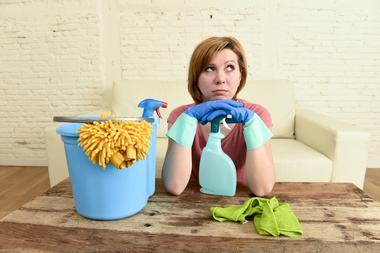Wood furniture is timeless, your shag rug from the seventies? Mmm, not so much.
In order to preserve its natural beauty, it is essential to polish regularly because beautiful wooden furniture never goes out of style.
Even your oldest piece of wood furniture can look like new if you take the time to read these cleaning tips on how to properly polish your wooden furniture.
Important Facts before You Start
Only use oil on wood that has an oil finish
Furniture oil like Tung and Linseed oil evaporate, get tacky and the remaining residue dries to a hard and protective finish. Wood oil can be applied as needed, but is not appropriate for all wood finishes.
Oil and wax don’t mix
You knew that, right? Don’t ever add wax to wood with an oil finish and don’t ever add oil to wood with a wax finish. A chemical reaction occurs between wax and oil that will degrade them both. The wax will become opaque and attract dirt and dust and will need to be completely removed if you even want a hope that it will look beautiful again.
Don’t use olive or vegetable oil
Vegetable and olive oil is great to cook with, but not to polish your furniture. Nuts, vegetable and olives spoil and the oils will go rancid (oxidize). Rancid oil smells bad, and it’ll be permeated in your wood and make it smell bad too.
Only damp dust Polyurethane finishes
Wax and polish don’t help and will actually damage polyurethane finishes.
Avoid Silicone polish
Silicone polish is very shiny, but it does not nourish the wood and it’s impossible to remove.
I’d only use it as a very last resort, when a piece is on its last legs and you are not worried about restoring it.
Silicone-containing cleaners/polish will not come off with detergents and have to be mechanically removed. You cannot stain or lacquer over silicone.
Wood Polishes
Wood polish is used to protect against abrasions and gives your furniture a shiny appearance. While polish evaporates more quickly than wood wax, it is much easier to apply.
Natural Wood Polish Recipes
Mineral oil is used to rehydrate and protect wood furniture from stains, spills and liquids, while vinegar cleanses it. Pour the mixture in a bottle and you’re ready to go!
Mineral Oil and Vinegar
One cup mineral oil
One fourth cup white distilled vinegar
Mineral oil repels liquid, while lemon extract cleans and leaves a fresh scent. Simply stir the mixture together and store in a glass or plastic container.
Mineral Oil and Lemon Extract
One quart mineral oil
One tablespoon lemon extract
Wood Waxes
Wood wax often contains beeswax and creates a protective seal on the wood, which keeps moisture in and repels stains and moisture that could harm your wooden furniture. Instead of the glossy finish achieved with wood polish, wax polish will leave more of a glowing sheen.
Colored or Pigmented Wax
Colored or pigmented wax or polish can enhance the wood color of the finish. A pigmented wax will conceal any nicks, scrapes, or blemishes in the wood color or the finish. Waxing with a pigment will leave a warm satin sheen. You may also reapply a clear polish or wax over pigmented wax if you desire a more glossy shine.
Clear Wax
Clear wax is appropriate for all wood furniture, regardless of the type or the color of wood. Clear wax shines wood to a high glossy finish. This is the case where less is definitely more. Too much clear wax applied to the finish will make the wood look dull and lifeless. The key to getting the high shine is to apply one coat of wax and buff, buff, buff.
Pine Wax
Pine wax works very well on both unfinished and light colored wood furniture. When wood has been finished, it will have a naturally rich and deep color. After applying pine wax to your furniture, your light colored wood and unfinished wood will posses a deep, rich tone that looks natural. You can also use a clear wax after applying pine wax to achieve a glossy shine.
How To Polish and Wax Wood
Now that we’ve gone over the facts, let’s get down to the business of polishing or waxing, shall we?
You can use either wood polish or wood wax, but now you know the difference between the two.
If your wood has a wax finish, stick with a wax polish. If your wood has an oil finish, stick with an oil polish.
Gather your tools and supplies:
Wood polish or wood wax (recipe above)
Clean cotton rags
A soft bristle brush
A soft buffing cloth
Polishing
1. Apply wood polish directly onto the clean cotton rag
2. Begin wiping with the grain
3. If your wooden furniture has intricate details, dab the wood polish directly onto a soft bristled brush and continue to use a circular motion
4. If your furniture needs more wood polish, apply another layer and wait for it to fully saturate
5. Use the soft buffing cloth to remove any excess wood polish
Waxing
1. Apply a small amount of wood wax directly onto the clean cotton rag
2. Begin wiping with the grain, starting in one position and working your way out
3. Let the wood wax set for an hour
4. Repeat steps one through three if you feel your wood furniture needs more protection
5. Buff using a clean, soft buffing cloth to remove the excess wood wax
All rights reserved to the initial publisher for House Cleaning Central.
Collected and published by Arms &McGregor International Realty® editorial team. Get in touched with us at [email protected]

